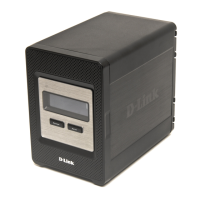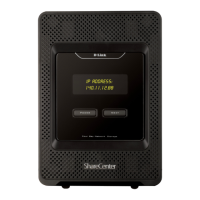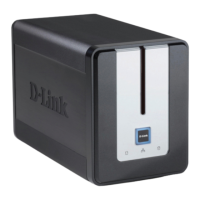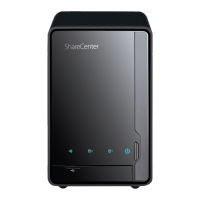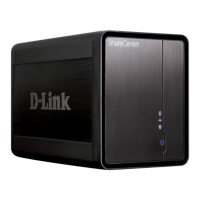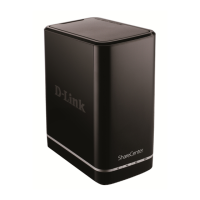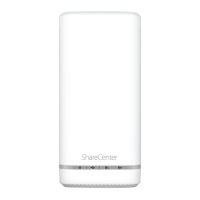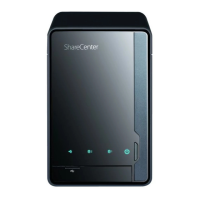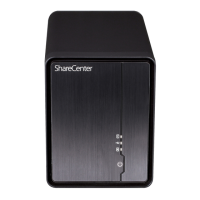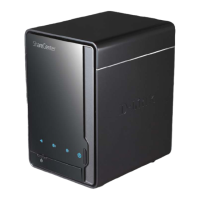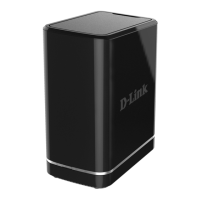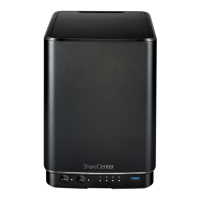
Do you have a question about the D-Link ShareCenter DNS-340L and is the answer not in the manual?
| Form Factor | Desktop |
|---|---|
| Number of Bays | 4 |
| Installed Devices / Modules Qty | 0 |
| Hard Drive Capacity | 0 GB |
| Network Interface | Gigabit Ethernet |
| Device Type | NAS |
| Compatible Drive Type | SATA |
| Maximum Internal Raw Capacity | 16 TB |
| Interface | SATA |
| Supported RAID Levels | RAID 0, RAID 1, RAID 5, RAID 10, JBOD |
| Processor | 1.6 GHz |
| Connectivity Technology | Wired |
| Data Link Protocol | Ethernet, Fast Ethernet, Gigabit Ethernet |
| Network/Transport Protocol | TCP/IP |
| Remote Management Protocol | HTTP, HTTPS |
| Features | Download client, iTunes server, print server, FTP server, backup server |
| Noise Level | 29.5 dB |
| Operating System Support | Apple MacOS X, Linux, Microsoft Windows |
| File System Support | FAT32, EXT3, NTFS |
Highlights the key features and capabilities of the DNS-340L.
Details the physical components and interfaces of the DNS-340L, including front and rear panels.
Guides users through the physical installation and setup of the hardware components.
Guides users through the installation process using the setup wizard.
Describes the default mode creating separate volumes for each drive.
Details combining drives into a single volume for maximum space.
Explains striping data across drives for performance.
Describes mirroring drives for redundancy and data protection.
Explains combining drives with parity for fault tolerance.
Details striping mirrored RAID sets for performance and redundancy.
Overview of the ShareCenter web UI sections: Home, Applications, and Management.
Guides users through basic device configuration using the web UI.
Tools for configuring disk volumes, RAID, and performing diagnostics.
Manages user and group accounts, including permissions and shares.
Controls and manages LAN settings, including IP, VLAN, and IPv6.
Manages various services and server settings like FTP, AFP, and NFS.
Handles system settings like time, date, device configuration, and power management.
Steps to create a new iSCSI target, including alias, volume, and CHAP settings.
Guides on creating a new virtual volume for iSCSI targets.
Manages user and group accounts, including creation and permissions.
Sets storage quotas for users and groups to limit allocated storage.
Configures shared folders and rights for users and groups.
Guides through adding or modifying network shares and folder access rights.
Syncs and confirms the connection to the mydlink account online.
Details features for iOS and Android devices for accessing NAS content.
Configures LAN settings like IP address, subnet mask, and gateway.
Sets up IPv6 connectivity modes: Auto, DHCP, Static, or Off.
Improves performance and reliability by bonding LAN connections.
Configures UPnP port forwarding for automatic router setup.
Configures settings for the FTP server, including user limits and ports.
Creates a media library for photos, videos, and audio files.
Configures the iTunes server for sharing music to computers on the network.
Configures and updates the system's time, date, and timezone.
Configures network UPS settings for power failure protection.
Displays current status of system components like LAN, device, and volumes.
App to create photo albums and share images via Picasa, Facebook, Flickr.
Provides access to all files on the NAS, with options for managing them.
Allows users to add, view, edit, and play music files from the NAS.
Manages IP cameras, allows streaming video saving, and connects up to 4 cameras.
Displays live video streams from IP cameras with customizable controls.
Allows playback of previously recorded videos with various controls.
Provides access to camera setup options including camera, audio, and recording.
Configures camera settings, including wizard, list, search, and auto-install.
Sets recording options including quota, event, and mode.
Configures ShareCenter NAS backup and restore for IP camera recordings.
Backs up ShareCenter data to another ShareCenter, Linux Server, or vice versa.
Configures ShareCenter as a backup destination for Mac OS X Time Machine.
Syncs data with Google Drive account, creating a directory on the DNS-340L.
Syncs files between Dropbox and a selected ShareCenter folder.
Details RAID options like Standard, JBOD, RAID 0, RAID 1, RAID 5, and RAID 10.
Connects a UPS to the NAS for power failure protection and shares UPS status.
Lists features like RAID configurations, migration, formatting, and testing.
Details features for managing user accounts, groups, quotas, and mydlink.
Details backup options: PC to NAS, local, remote, Time Machine, USB, and cloud.
Features for power saving, recovery, scheduling, fan control, and UPS connection.
